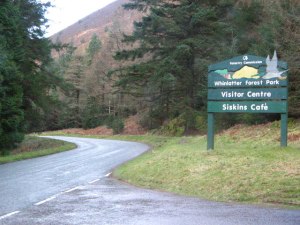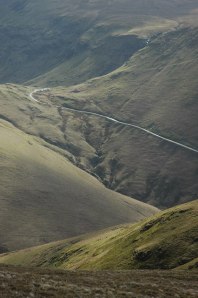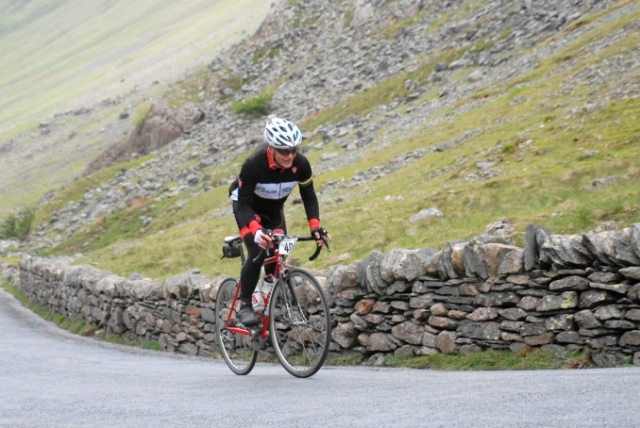I was nervous before this one. It’s true that it was only going to amount to 105 km (65 miles), but there were going to be no junk miles here. A look at the profile was enough to set nerves jangling. MemoryMap claimed 2961m (9716ft) of climbing, and even allowing for the usual exaggeration of this system it looked like a punishing ride. In most sportives this amount of climbing would normally be spread across a 100 mile route. In addition there were a number of 25% sections and a section at 30% on the final climb of the day. Still it was only 65 miles so I told myself that there was nothing to fear. Then I looked at the weather forecast. Light rain in the early morning was to be followed by heavy rain in the early afternoon, all this to be blown in by strong south westerly winds which would be storm force in exposed locations by the afternoon.
I had originally planned to set off at about 8.30, but opted for an early start in order to avoid the worst of the conditions. It was grey and distinctly windy on arrival in Keswick and despite the usual prevarication and last minute changes of kit, I was on the start line at 7.30 and on my way towards the first climb of the day. As you would expect with the condensed nature of the route, it was only 5k to the bottom of the first climb in Braithwaite.
 Whinlatter Pass is one of the gentler passes in the Lakes and rises with continental type gradients through the forest of the same name. Nevertheless as the first climb of the day it was still a hard effort and it was a relief to reach the highest point at 318 m. There were a few spots of rain on arrival at the top, but the road was still relatively dry so the descent was rapid and as always, too short.
Whinlatter Pass is one of the gentler passes in the Lakes and rises with continental type gradients through the forest of the same name. Nevertheless as the first climb of the day it was still a hard effort and it was a relief to reach the highest point at 318 m. There were a few spots of rain on arrival at the top, but the road was still relatively dry so the descent was rapid and as always, too short.
The route then took us through the pretty village of Lorton and along the breathtaking shores of Crummock Water. The Buttermere valley has always been a special place for me since I took my first tentative steps on to the fells whilst staying at Hassness as a late teenager. Little has changed since then, and I still think that it is the most beautiful corner of the Lake District. There were signs of things to come as the crosswind made forward progress fairly difficult and climbing gears were engaged for false flats which would normally be dispatched with ease. Still, the clouds were high and the rain was holding off.
On the edge of Buttermere village we took a left turn and immediately the road ramped up and on to the early slopes of Newlands Hause. After a very steep start the climb relented slightly and took a straight ascending line up the steep side of the valley. The last few hundred metres ramped up again to 25% just to underline that this was still a serious climb.
 We then dropped steeply towards Newlands Valley and a rolling road back towards the shores of Derwentwater. Near Stair, the sun started to break through and teased us with the suggestion of better weather to follow.
We then dropped steeply towards Newlands Valley and a rolling road back towards the shores of Derwentwater. Near Stair, the sun started to break through and teased us with the suggestion of better weather to follow.
After dropping into Borrowdale the route crossed the river via the double bridge at Grange and headed past Castle Crag and into the mountain enfolded upper reaches of the dale. All too soon I found myself in Seatoller, I swallowed a gel and prepared myself mentally for the first ascent of Honister Pass. Some climbs try to intimidate you from the start and this side of Honister does just that. Immediately after you leave the village the road steepens and continues to do so as you climb through the trees. I was glad of my compact chainset and 28 tooth sprocket as the road did its best to bring me to a halt. Several times I had to stand up in order to keep the front wheel in touch with the tarmac. Eventually the road left the trees and after a short while, the gradient relented and the views to the upper part of the pass were revealed. Just before arrival at the top, the gradient increased again and the pass extracted it’s final toll before levelling out by the quarry buildings. I swiped my timer card at the control and then wasted a good 3 or4 minutes trying to find my packet of energy drink so that I could refill my bottle. The wind was really whipping across the top of the pass which didn’t bode well for the return leg when it would be almost a direct headwind. Little did I know that the wind would be a significant factor rather sooner than that!
The Buttermere side of Honister is the opposite of the Borrowdale side. The first section varies between 25% and 30% and thus the descent starts quickly. Swooping down between the rocky hillsides at more than 40 miles an hour, I suddenly became aware of the bike becoming unbalanced. The wind was eddying round between the steep sides of the valley and throwing me from side to side. Although the gradient was easing I saw that I was approaching a small bridge and felt as if I was in danger of being pushed into the stone parapet. I scrubbed off some speed and full control was re-estabished. I breathed a sigh of relief and soon found myself on the gradual lower slopes of the pass.
In all my years of cycling I had never experienced such an event and was quite shaken. I was joined by some other riders at the bottom, and on comparing notes it turned out that it had been the same for all of us.
I rode along the shores of Buttermere, through the village and then retraced the route along Crummock Water until I arrived in Lorton and started the second ascent of Whinlatter, but this time from the West. This proved to be the gentlest climb of the day, which was a relief with all the climbing that had been done and all that was to follow. From the second visit to Buttermere I had gradually been seeing more and more riders coming the other way. It must have been quite disheartening for many of them to have seen early starters a considerable way into the route when they were in the early stages.
This second half of the ride had minimal gaps between the climbs and thus the foot of Whinlatter soon led on to the gentle lower slopes of the Newlands climb. At first the road rose steadily in a generally upward direction along the sides of one of the quietest valleys in the North Lakes. As we dropped down to cross Rigg Beck, I instinctively looked for the prominent landmark of the ‘Purple House’. It wasn’t there, and then I remembered that it had burned down in 2008. This shabby old building had looked like something from the ‘Adams Family’ with its dilapidated purple painted walls and general air of neglect. In its place was a brand new, architect designed structure which I’m sure is very beautiful but somehow failed to fit in to my idea of the place as well as its eccentric predecessor. As the shabby corners of the Lake District get tidied up and made more respectable, I fear that something of the organic wildness of the area is lost. Or maybe I’m just a sentimental romantic.
Back to the job in hand. The road was steadily getting steeper and the southerly wind was acting as what I can only describe as a three quarters headwind. As I headed towards the steep climax of the climb, I heard the swoosh of helicopter blades and saw the air ambulance readying itself to land about half a mile ahead. By the road there was the tell tale huddle of people and a small tent. The helicopter landed and I moved on. At this stage I surmised that a cyclist must have come off the road at the end of the steep descent. If that was the case then I suspect that they were moving at some speed and had been caught by a gust of wind. I set off for the crux of the climb with a heavy heart and hoped that no-one was badly hurt.
The final section of this climb was at a good 25% and the cross wind made for a difficult time at this stage of the ride. After I crested the climb, I warned the cyclists coming up the other way of the dangerous winds and took the exhilarating descent to Buttermere.
The clouds were beginning to lower and the skies behind the High Stile ridge were black and angry looking. It was with a strong sense of foreboding that I rode towards the head of Buttermere and the final climb and second ascent of Honister.
As I arrived at Gatesgarth Farm which stands at the foot of Honister I was joined by a strong group of cyclists and we all took turns to go on the front along the fairly gradual lower slopes of the pass. The wind was now fully in our faces so the turns at the front were short and strenuous. Ahead rose the rapidly steepening upper slopes of the pass. I looked ahead and for the first time, seriously doubted whether I would make it to the top without walking. I took a gulp from my bottle, ripped open a gel and metaphorically girded my loins. There appeared to be five pitches, each of the first four slightly steeper than the last and the final one looking slightly easier. I broke the climb down this way and counted them off. By the foot of the fourth one I had hit 193 on my heart rate monitor (I didn’t think I could still get to that level!), and I was faced with a 30% gradient.
 Then I saw the Sportsunday photographer. Pride took over and I hauled myself up and over. The last 25% section felt easy by comparison and I reached the control and flopped over my bike while my chip was scanned.
Then I saw the Sportsunday photographer. Pride took over and I hauled myself up and over. The last 25% section felt easy by comparison and I reached the control and flopped over my bike while my chip was scanned.
There were no more climbs and about 8 miles to ride. The descent was dispatched quickly and then there was the ride down Borrowdale and back to the finish.
Now I buried myself in a way that I knew I would pay for the next day. I selected the big ring and the small sprocket and dredged up the last remnants of energy and adrenaline. I flew down the valley as fast as I was able and used any cyclists I saw ahead of me as a target to overtake. As I arrived at the finish I swiped my chip and breathed a sigh of relief. It’s still a mystery to me where that last burst of energy comes from when the end of an event is in sight. At the top of Honister I had been on my last legs and yet I seriously doubt that I could have ridden any faster over the last few miles, even if I had been fresh. At the beginning of the ride I had set myself a target of 4hours 30 minutes. Even with the dash at the end, I only managed 4 hours 42 minutes, so perhaps I overestimated my fitness,but perhaps I can blame the wind.
It was one of the hardest mornings I’ve ever spent on a bike. There were few level stretches in the first half, and virtually none in the second until the last mad romp down to the finish. Like all the best sportives, the route felt like a natural challenge and had its own logic. The final ascent of Honister and the time trial down Borrowdale will stay etched in my memory for a long time.
Some statistics
Recorded Distance: 65 miles (as measured on my computer)
Duration of ride (via Sportident timing): 4 hours 42 minutes and 46 seconds
Average Heart Rate: 162
Maximum Heart Rate 193
Position (not that it’s a race!) 36/160
Total ascent (calculated via Memorymap): 9,716feet, 151 feet per mile
Comparison of ascent per mile: Keswick Sportive 151ft per mile, Fred Whitton 128 feet per mile, Lakeland Loop 122 feet per mile, Le Terrier HC 117 feet per mile.
